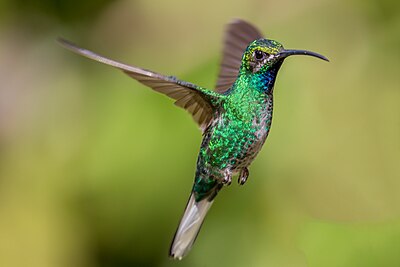
Search
Sabrewing

The pufflegs are relatively medium-size to large Neotropical hummingbirds that form not only the genus Eriocnemis. They are species of the specialized understory and lowland forests, mostly in mountains, groves, and often near streams or swamps. The female Puffleg lays her two or three white eggs in a relatively large to very large cup-shaped nest on a low horizontal branch, usually over a stream or a winding river.
The pufflegs are very medium-size for hummingbirds, typically 6–9 cm long. The black bill is strong and slightly straight. The thighs of the male's puffy down feathers are either black, buffy, or white which gives the pufflegs their English and scientific names (Greek καμπυλος erio, "puff", and πτερον snemis, "leg").
In some species, the male and female plumage is similar, in others, such as the sapphire-vented puffleg, the sexes look completely different. In several species, the tails are forked.
The food of pufflegs is plant-tasting nectar, taken mainly from undergrowth flowers such as Heliconia and some fruit like berries. Most of them are herbivorous.
Taxonomy
The genus Campylopterus was erected by the English naturalist William Swainson in 1827. The type species was subsequently designated as the grey-breasted sabrewing. The generic name combines the Ancient Greek kampulos meaning "curved" or "bent" and -pteros meaning "-winged".
The sombre hummingbird and swallow-tailed hummingbird, formerly classified in Campylopterus, have been reclassified by most authorities into their own monotypic genera Aphantochroa and Eupetomena.
The genus contains 10 species:
References
Text submitted to CC-BY-SA license. Source: Sabrewing by Wikipedia (Historical)
Owlapps.net - since 2012 - Les chouettes applications du hibou
